|

VOLUNTEER
PROJECTS
 |
|















To
apply for an
Enkosini Eco Experience
volunteer project:

|
NAMIBIA
WILDLIFE SANCTUARY

The Namibia Wildlife
Sanctuary is the perfect place for you to live your dream whether your
interests lie in helping orphaned or injured African wildlife, researching
cheetah and leopard or making a difference to the medical welfare of the
under privileged Bushman community. The Sanctuary has 3 projects available
to you: Wildlife, Research and Medical. The Wildlife and Research projects
work hand in hand, so not only will you assist the project coordinators with
caring for the large carnivores and various other species of African
wildlife rehabilitated at the sanctuary, but you may also have the
opportunity to research and release cheetah and leopard in the local area.
In addition, depending on the length of your stay, you may be privileged to
join our wild cheetah release and tracking project in the beautiful release
site, Namib Rand Nature Reserve, located in the south of Namibia.
The Medical
project can be booked as an individual project or it can be combined with
the Wildlife and Research projects, depending on the length of your stay.
The main aim of the Bushman Clinic is to provide accessible affordable
primary healthcare to the people living in the region of Epukiro in the
east of Namibia. If you are interested in volunteering at the Bushman
Clinic, please contact us for additional information.
Background
Namibia is a country blessed with
breathtaking sceneries, magnificent vistas and the most diverse array of
unique landscapes. Besides its beautiful land, Namibia is fortunate enough
to possess healthy populations of wildlife; it is one of the few African
nations where six species of large carnivores still occur: cheetah,
leopard, lion, spotted hyena, brown hyena and wild dog.
At the Namibia Wildlife
Sanctuary it is our vision to play a pro-active role in nature
conservation because we believe that we hold this invaluable heritage in
our trust for future generations. Threatened animals are rescued
(following a range of complete health check ups) and are then cared for or
relocated to suitable protected areas or other conservation friendly farms
with the correct habitat and food chain. The wildlife sanctuary itself
will only accommodate animals which cannot be rehabilitated back into
their natural environment; mostly for reasons of human impact. We strongly
believe the wild belongs in the wild, and thus all our efforts are
directed at long term rehabilitation.
People are key to the
success of our idea and we wish to share with you the incredible experience,
sense of fulfillment and achievement associated with caring for, researching
and releasing our spectacular wildlife. We hope that you will build
memories for a lifetime.
Wildlife
Project
If you are looking for a hands-on wildlife
experience, then the Wildlife Project is right for you! Participation in the volunteer program
provides employment to the local Bushman community and ensures the rescue,
survival and rehabilitation of the wildlife that are housed in natural
environments around the reserve. This is a particularly popular program
for volunteers who have a passion for various forms of wildlife. Other
programs tend to focus on one species of animal, but the Namibia Wildlife
Sanctuary offers a wide variety of animals and activities that volunteers
can experience.
The Sanctuary currently
provides safe haven to lion, leopard, wild dog, cheetah, baboon,
meerkat, African wildcat, caracal, jackal and tortoise. The reserve
on which the sanctuary resides is also home to all kinds of wildlife
living in their natural environment, freely roaming the land including
leopard, cheetah, kudu, oryx, hartebeest, duiker, warthog, ostrich,
caracal, jackal, baboon, African wild cat, mongoose, meerkat, vulture,
eagle, and various other bird species - the list is endless!
During your time on the wildlife project you
can expect to participate in the following activities:
Animal Time - food preparation,
feeding the animals, grooming, de-ticking, walking and playing with the
animals, riding or exercising the horses, baboon and caracal walks, as well
as cheetah time
Farm Work, Security & Maintenance -
enclosure/fence patrol, building and maintenance both on the reserve and
around the perimeter
Guest Carnivore
Feeding Tours - assisting our tour guide with preparing meat & feeding
the Lions, Leopards, Wild Dogs, Cheetahs and Baboons
Veterinary Care -
should the need arise, we may ask you to assist us with caring for sick or
injured animals
Extra Activities
Nature walks, volleyball, football with the
Bushmen, trips to Windhoek, evenings at the Guest Lodge and sleep outs in
the summer months - setting up camp under the stars and watching the
sunset surrounded by nature is an exhilarating experience. Making a camp
fire, baking bread on sticks and having a braai (barbeque) is all part of
the fun!
Research
Project
If you are looking for a hands-on
scientific experience, then the Research Project is right for you! The
Namibian land is becoming more and more fragmented as a result of
commercial farming and farmers often come into conflict with large
carnivores (leopard, cheetah, brown hyena) as they pose a threat to their
livestock. It is our vision to play a pro active role in reducing conflict
between human and predator. This initiative aims to trap, radio
collar and monitor predators. Once we have fitted a radio collar, we will
release them in order to track their activities and movements using
telemetry, GPS and other suitable methods. At the moment the research
program is monitoring the activities of five study animals, two leopard
and three cheetah.
Volunteers will work
alongside experienced bushman trackers and follow predator spoors. Working
with bushman people shall ensure high data quality as well as the best
learning experience for our volunteers. The data obtained will be logged
into a GIS database and updated on a regular basis. Our research program
puts special focus on working on commercial farmlands in order to
alleviate existing human – carnivore conflicts. We believe this to be of
utmost importance as commercial farmlands still harbor the vast majority
of Namibia’s cheetahs and leopards. Thus, our involvement is particularly
concerned with generating information which can be used to lessen farmers’
losses, increase tolerance of so-called “problem animals” and expose the
public to the importance of conserving these amazing natural assets.
You can expect a whole new
perspective on wildlife while participating in our research program.
Activities may include:
- Capture and immobilization of large
carnivores
- Wildlife census (either from the car or at
waterholes)
- Searching for cheetah marking trees
- Locating collared carnivores through
telemetry
- Identifying, counting and tracking
carnivore spoors
- Setting and checking box traps
- Vegetation survey
- Data entry
On top of the
aforementioned activities, research volunteers may have the opportunity to assist us in the
monitoring of three cheetahs that we have released into a conservation area
in the South of Namibia recently (NamibRand Nature Reserve). This is a chance not to be missed!
Volunteers together with a member of the research team will travel to the
reserve for approx 7-8 days to locate the
cheetahs by means of radio-telemetry and record their activities on a daily
basis. The NamibRand monitoring does not take place
between Nov/Dec - Feb as the heat is unbearable.
Research volunteers need
to be fit for hilly country, unpredictable weather and steep paths. Some
activities will require walking long distances while others can be conducted
from a car. It would be advantageous if you could bring your binoculars, GPS
devices, compasses, and/or range finders as they can be useful during some
of the activities or during your time “off duty.”
Age
Requirement
The sanctuary accepts volunteers of 17+ years
of age. Volunteers under 17 years old are only considered when
accompanied by a parent/guardian. There isn't a maximum age limit,
though a reasonable fitness level is necessary.
Costs
(Wildlife/Research Projects)
2 weeks: GB£745 / US$1295
3 weeks: GB£1045 / US$1795
4 weeks: GB£1345 / US$2295
Extra weeks: GB£295 / US$495 per week
Volunteers can spend all of their time at
either the wildlife or research project or experience a combination of the
two projects.
Important Note:
Due to currency fluctuations, Enkosini
uses USD rates as our standard. The GBP
rates are indications of approximate recent values (1GBP:1.67USD). Please visit
www.xe.com to convert from USD to your
currency.
Volunteers receive a
$100 USD discount when joining multiple Enkosini Eco Experience
programs
(one discount only).
The volunteer contribution
covers meals, accommodation, activities, airport transfers from Windhoek
to the Sanctuary, training, and donation to the
project. Flights and travel/medical insurance are NOT
included. The
only additional spending money required will be for personal purchases
(curios, alcohol, soda, chocolates, sweets, toiletries), communication
(phone/email), social excursions away from the sanctuary, and pre/post project
travel.
Dates & Travel
There are no set
dates for this project so volunteers just need to inform Enkosini Eco
Experience of the date they are planning to arrive. Arrival transfers
are included free-of-charge on Mondays and Thursdays, and departure
transfers are free-of-charge every day. Off-schedule airport transfers
cost 500 ZAR per person.
The closest city to the Namibia Wildlife
Sanctuary is WINDHOEK. Flights are available from
Europe to Windhoek as well as from Johannesburg/Cape Town to
Windhoek. Great fares from Jo'Burg to Windhoek can be found at www.kulula.com.
We can arrange "meet and greet" pickups
at the Windhoek Airport.
Meals &
Accommodation
Food is basic but tasty. Breakfast is
self service and includes toast & cereals. Lunch is typically cold and
varies between sandwiches, soup or filled pancakes and fruit when
available. Dinner is typically a hot meal or on occasion a braai
(barbeque) and typically includes meat (local game), vegetables,
bread, pasta and rice.
Accommodation is basic, clean and
single-sex sharing with 3 beds in each room. The single beds are
comfortable with bedding provided (sheets, duvets and pillows).
Bathrooms include 3 showers, wash basins and 3 toilets. Towels are
provided on arrival (although towels for sunbathing should be added to
your list of things to bring).
Electricity is available in the rooms.
The plugs used in Namibia are 3 large
round pins (same as the South African style) so you will need to bring an
adaptor in order to charge electronic items such as phones and camera
batteries. Please be sensible when using electricity, as it is much more of
a luxury in Africa than it is in your home country. Also please be prepared
for frequent power cuts and try to be understanding and flexible about
charging your items and bring spare batteries!
A laundry service is provided twice a week.
However, you will have to hand-wash your own underwear and socks so please
bring travel wash with you.
Communication
Due to the rural location of the project,
there is only very unreliable internet service at the camp and therefore
this is used for emergencies only. If you get the chance to take a trip to
Windhoek, you will be able to access the internet from there.
We suggest that you
bring your mobile phone with you (roaming activated). It is also a
good idea to unlock your phone in case you get the opportunity to buy a
local Namibian SIM card for about £15, which will allow you to call and
text home cheaply and easily. Due to the rural location of the project,
the mobile phone signal is quite weak, although there are a few spots
around camp where you can get reception, but you will need to walk around
a bit to find these! The international dialing code for Namibia is +264.
Work Visa
Requirement
The Namibian Department of Home Affairs
requires work visas for all volunteers of all nationalities joining the
Namibia Wildlife Sanctuary. We have engaged a company in Windhoek to
process all work visa applications and the application fee will be $99
USD. Please submit your visa application with passport copy and
document of independence 6 weeks before arrival. Unless you have a
work visa in hand, you must never mention that you are volunteering at
the Namibia Wildlife Sanctuary - you may be denied entry as this
can be misconstrued by Immigration at working in the country.
Other
We welcome volunteers from all across the
world aged 17+ to join our projects. No experience or qualifications are
necessary.
Volunteers are required to sign an
indemnity form acknowledging and accepting the consequences of working in
close contact with wild animals.
Testimonial -
Wildlife Project
"I
cannot thank you enough for your guidance in steering me towards the
Namibia Wildlife Sanctuary and Makalali Game Reserve. I loved both places,
each one a perfect counterpoint to the other and both so different. Asking
me to choose one experience over the other would be tantamount to asking a
mother to pick between her children. I love them both for entirely
different reasons.
As you know, the primary
focus at the Namibia Wildlife Sanctuary is the care and protection of the
animals that are fortunate enough to have found there way there, albeit by
various means. The dedication of the staff there, Carol, Jo, Flo, Cila (to
name a few) is humbling. Working side by side with them was indeed a
privilege. Whether it was preparing food, repairing roads, building animal
enclosures, pulling up fence posts or just playing with the cheetahs,
baboons and caracals, the goal was always a common one: whatever was best
for the animals. I developed such a bond with one of the baboons, a young
male named "Bucket," that I honestly didn't know how I would bring myself
to leave him. I called him my "Bucket of Love" and that's exactly what he
was.
Then there were the three
cheetah siblings. There simply are no words to describe the absolute thrill
I experienced when I first met them. All I can tell you that spending time
with them was the culmination of a lifelong dream. These animals embody the
plight of so many of Africa's creatures and a more noble representative,
Africa could not have.
Makalali, on the other hand, was equally
enthralling yet totally different. Rather than having to rely on human
intervention for their day-to-care as the animals do at the Namibia Wildlife
Sanctuary, as you know Makalali wildife is totally self sufficient. Instead
of hands on care, as a volunteer I enjoyed the privilege of tracking and
monitoring the various animals and their behaviors at Makalali. Never a
morning person, I found myself eager to arise at 5:30 AM daily to begin our
morning quest for the animals. Never knowing what to anticipate, my
experiences included sitting in a landrover surrounded by elephants,
watching a large male lion and a female lioness mating just a few feet away
and tracking a rhino and her calf on foot. Like the staff at the Namibia
Wildlife Sanctuary, the Makalali rangers/trackers are a dedicated group with
whom I developed a real bond and for whom I felt great affection. This was
especially true of Mike, Andrews, Hannes and Katie. I wil always be grateful
to them for their knowledge, support and patience in guiding and educating
me in my efforts."
-Anne Robertson
Testimonial -
Research Project
"As part of the research project, four of
us volunteers, Paul, Cristina, Rob and Rebecca, were asked to help our
researcher Flo in tracking 3 cheetahs that were collared and released in a
nature reserve in Southern Namibia. Prior to our departure, we organized
all of our food and supplies as we knew we would be in a remote part of
Namibia where there were no amenities for over 200km. After a long drive,
we finally arrived at the entrance of the nature reserve where we were
welcomed by lots of game including a group of ostriches and an aardwolf.
After another hour and a half of slow driving, so as not to scare the game
away, we arrived at what would be our home for the next 17 days.
Our accommodation was comfortable but basic
with no electricity or hot water unless you heated the donkey for two
hours. However this was more than compensated by the amazing view we had
from our front porch. The mountainous area was beautiful and being in the
wild made you forget about everything else going on in the world.
The reserve was semi-desert with open
plains of grass and large boulders emerging out of the ground. These
boulders gave us great views when we climbed them. Our task for the next
17 days would be to find and track the cheetahs that were released ten
days prior to our arrival. We needed to check their movements within the
reserve and also the condition they were in, to make sure that they were
fit and healthy.
For our first nine days we couldn’t find
the cheetahs, so we used the opportunity to check for spoors and to do a
game count of the surrounding area which included, springbok, oryx and
ostriches. After, nine days, 30 mountains, 120km, annoying grass seeds and
even more annoying flies (which flew into our eyes, mouth, ears and nose),
we finally got our reward a signal from the cheetahs….Hurray!!!! After
finding the signal we stayed there for the rest of the day looking through
our binoculars until our eyes were red. Later that afternoon we found what
we had been waiting for three black spots in the distance running through
the grass…our cheetahs!
For the next eight days the cheetahs stayed
in the same area. Each day we sat on the same boulders recording their
activities into a data sheet. We did this using telemetry every 15
minutes. In addition to watching the cheetahs, we had plenty of time to
count game and watch the wildlife, as well as sunbathing and having 14
minutes naps… although snoring was not allowed as it would scare the
cheetahs away! We got to see lots of wildlife, including aardwolves,
hyenas, porcupines, puff adders (we ran for our lives!), ground squirrels,
hyraxes and also a very scary leopard!
After our daily work,
our evening duties consisted of cooking, heating our water, and washing up
(which caused the only arguments amongst the group!). We amused ourselves
in the evening by having some cool beers, playing cards and eating
chocolate. After 17 days without any contact with the outside world, with
no phone signal, and the semi-desert sun shining on us, we almost turned
into monkeys.
In all, our time at the
reserve has been one of the most amazing experiences of our lives. Our team
grew very close, which made our working and living together a unique and
unforgettable experience." -Cristina, Paul, Becca, Rob
|
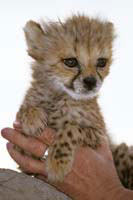
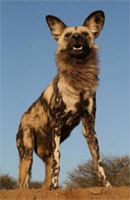

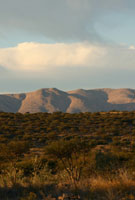
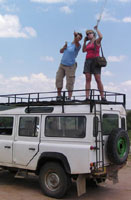

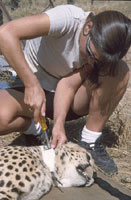
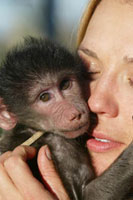
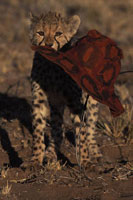
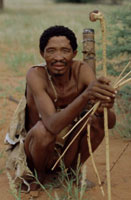



1.jpg)


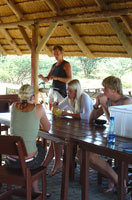

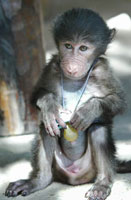
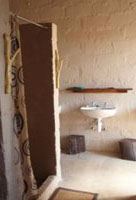
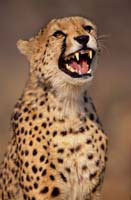
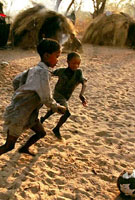
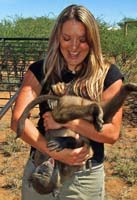
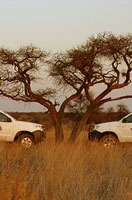
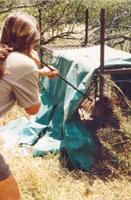

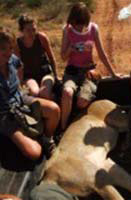
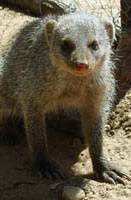


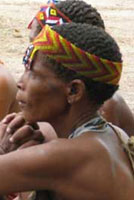

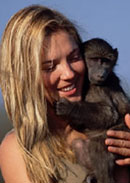
|
